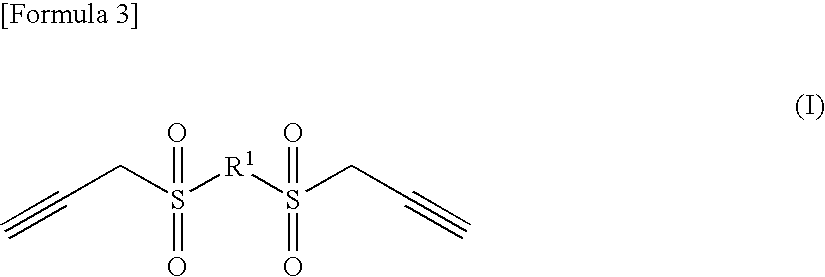Nonaqueous electrolyte solution for lithium secondary battery and lithium secondary battery using the same
a technology of lithium secondary battery and nonaqueous electrolyte solution, which is applied in the direction of non-aqueous electrolyte cells, cell components, electrochemical generators, etc., can solve the problems of increasing resistance, further increasing power consumption, and worsening battery characteristics such as cycle properties, so as to prevent gas generation and excellent battery characteristics
- Summary
- Abstract
- Description
- Claims
- Application Information
AI Technical Summary
Benefits of technology
Problems solved by technology
Method used
Image
Examples
examples
[0095]Production Example for the sulfone compound of the present invention, and Examples of using the electrolytic solution of the present invention are given below.
production example
Production of 2,2′-bis[(2-propynylsulfonyl)ethyl] ether
[0096]A mixture liquid of 15.0 g (109 mmol) of bis(2-mercaptoethyl)ether and 24 g of methanol was dropwise added to 44.0 g (228 mmol) of 28% sodium methoxide / methanol solution with cooling in an ice bath, at an internal temperature not higher than 10° C. The ice bath was taken off, and at 25° C., this was kept stirred for 1 hour as a slurry, and then the reaction liquid was again cooled in an ice bath. Then, 54.8 g (228 mmol) of propargyl bromide was dropwise added thereto, and stirred at 25° C. for 30 minutes. After the reaction, the reaction liquid was poured into saturated brine, then the organic layer was extracted out with ethyl acetate, and the organic layer was dried with MgSO4 and concentrated to give 21.8 g (102 mmol) of 2,2′-bis[(2-propynylthio)ethyl] ether (yield, 94%). The resulting 2,2′-bis[(2-propynylthio)ethyl] ether was transferred into a reactor equipped with a reflux condenser, then dissolved in 60 g of water a...
examples i-1 to i-4
Preparation of Nonaqueous Electrolytic Solution
[0102]LiPF6 to be 1 M was dissolved in a nonaqueous solvent of EC / MEC=30 / 70 (ratio by volume), and further bis(2-propynyl) sulfone was added thereto to prepare a nonaqueous electrolytic solution, in an amount of 0.1% by mass of the resulting nonaqueous electrolytic solution (Example I-1), 1% by mass (Example I-2), 5% by mass (Example I-3) and 10% by mass (Example I-4).
[Production of Lithium Ion Secondary Battery]
[0103]94% by mass of LiCo1 / 3Ni1 / 3Mn1 / 3O2 (positive electrode active material) and 3% by mass of acetylene black (electroconductive agent) were mixed, and added to and mixed with a solution previously prepared by dissolving 3% by mass of polyvinylidene fluoride (binder) in 1-methyl-2-pyrrolidone, thereby preparing a positive electrode mixture paste. The positive electrode mixture paste was applied onto both surfaces of an aluminium foil (collector), dried, processed under pressure and cut into a predetermined size, thereby produc...
PUM
| Property | Measurement | Unit |
|---|---|---|
| Percent by mass | aaaaa | aaaaa |
Abstract
Description
Claims
Application Information
 Login to View More
Login to View More - R&D
- Intellectual Property
- Life Sciences
- Materials
- Tech Scout
- Unparalleled Data Quality
- Higher Quality Content
- 60% Fewer Hallucinations
Browse by: Latest US Patents, China's latest patents, Technical Efficacy Thesaurus, Application Domain, Technology Topic, Popular Technical Reports.
© 2025 PatSnap. All rights reserved.Legal|Privacy policy|Modern Slavery Act Transparency Statement|Sitemap|About US| Contact US: help@patsnap.com



